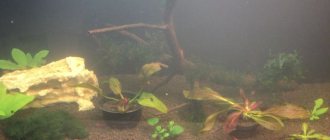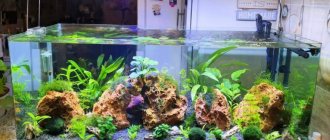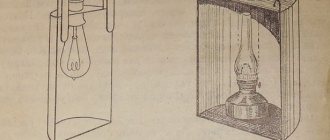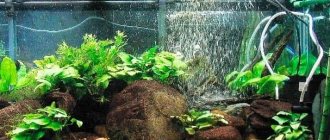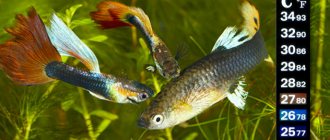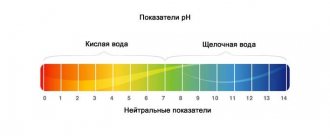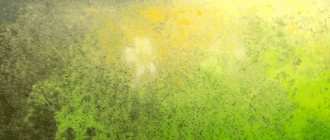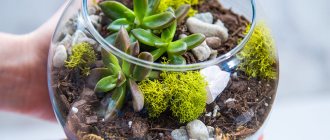Where does nitrogen come from in an aquarium?
Nitrogen is an important element, the location of which is chlorophyll, vitamins, ribonucleic acids, peptides, and protein molecules. The element enters the aquarium along with food for aquarium fish. By eating it, underwater inhabitants release urea and excrement into the water.
An aquarium is an integral, almost closed biological system
Determination of ammonia using tests.
Now, almost all manufacturers of aquarium equipment have special tests to determine the concentration of ammonia in water. From the simplest and not very accurate, to more advanced drip ones. The principle of operation is approximately the same for all. Or wet the strip, wait, and compare the results with the color scale on the attached diagram. Or take a water sample and add a few drops of the solution from the test kit. We waited and also compared it with the color scale. In any case, detailed and clear instructions will be included.
Below, the photo shows my ammonia tests in one of the aquariums.
As we can see, for correct test readings, we still need to take into account the pH of the water.
What is the nitrogen cycle
To maintain the balance of nitrogen in the aquarium or ammonia and phosphorus, the elements must be consumed by the fish, the remainder by the plants, and excess nitrates can be removed from the tank by trimming the plants and changing the fluid.
If the ecosystem of the tank is not able to process all the substances, ammonia, nitrites and nitrates accumulate in the aquarium, leading to an imbalance and promoting the development of algae.
In the right substrate, nitrifying bacteria multiply and help carry out the filtration process. Also, do not forget about the supply of CO2 to the aquarium.
Attention!
The nitrogen cycle is the circulation of nitrates, ammonia and nitrites in the reservoir, which is facilitated by fish, green spaces, and bacteria.
The nitrogen cycle is a very important component of both marine and freshwater aquariums.
The main reasons for the violation of water composition
Various factors can provoke an increase in the concentration of chemicals in aquarium water. Among them it is worth highlighting:
- accumulation of organic matter in the aquarium ;
- violation of tap water purification technology;
- poor filter ;
- a large number of fish in the aquarium;
- excess feed;
- deficiency of beneficial bacteria;
- non-compliance with temperature conditions;
- violation of the acid balance of water.
Infographics about ammonia
A combination of one or more of the above factors can cause an increase in the concentration of ammonia/ammonium in aquarium water.
How to fix moss, anubias, bucephalandra in an aquarium
Nitrates in the aquarium: how to reduce, check, fight and maintain
The smallest aquarium fish: types and care for them
TOP 20 most beautiful aquarium fish
TOP 12 most expensive aquarium fish
Aquarium fish that do not spawn, but give birth to fry
The water in the aquarium becomes cloudy: the reason, how to eliminate it
Heater for an aquarium. Temperature in the aquarium
Fish poisoning with ammonia, nitrites and nitrates
If the content of nitrates, nitrites and ammonium in the aquarium goes off scale, this has a detrimental effect on the inhabitants of the tanks.
Symptoms of fish poisoning with ammonia:
- feeling of lack of oxygen, difficulty breathing;
- change in body color - the back and abdomen become dark;
- noticeable changes in coordination of movements;
- damage is visible on the gills.
Symptoms of poisoning of aquarium inhabitants with nitrites:
- rapid breathing: as a result of lack of oxygen, the fish float closer to the surface;
- small fish often go into convulsions;
- depending on the immunity of underwater inhabitants, life expectancy is from a couple of hours to 2 days.
Symptoms of aquarium fish poisoning with nitrates:
- the fish are inactive, lethargic;
- the gills become pale, pets cannot breathe, which leads to death.
If there is a sharp increase in harmful substances, it is recommended not to hesitate - immediately transplant the fish into clean water. If signs of nitrate poisoning are observed, changing the water followed by the addition of special chemical conditioners will help save the situation.
It is necessary to monitor water parameters and the content of nitrates, nitrites and ammonium in it. If these parameters go off scale in a new aquarium, adding fish is strictly prohibited. Now we need to take all measures to reduce the concentration of harmful substances.
To avoid an increase in harmful substances, before purchasing an aquarium and keeping fish, you need to make calculations:
- number of individuals purchased;
- type of aquarium fish;
- the volume of the aquarium based on the number of its inhabitants;
- filter power;
- amount of fish food per feeding.
It is recommended to promptly remove food debris, dead fish, and other waste from the tank. To quickly reduce the concentration of harmful substances, you need to take care of purchasing high-quality filters with good filtration material.
Ammonia poisoning of fish is not uncommon.
Starting an aquarium: biological starting
In the previous material (Starting an Aquarium, Part I: Preparation) of this series, we told you, our dear reader, how to prepare an aquarium for launch. This is the most time-consuming stage of the launch, although it rarely takes us more than an hour or two. The second stage, without a doubt the most important, takes much more time, but at the same time requires much less effort and money too. It may sound paradoxical, but at the same time, this is the true truth. In this material we will talk about how to make a real, living aquarium from a set of individual elements - glass, plastic, soil and water.
In the first article of this section, we already talked a little about creating and maintaining biological balance in an aquarium (Equilibrium of Order) . It's not nearly as difficult as it might seem. At the same time, this knowledge is absolutely necessary for the aquarist - in order to maintain his aquarium viable and, most importantly, to do this consciously - understanding the interconnections of all the processes occurring behind the glass. Today we will talk about this.
What not to do
So, we have an aquarium, approximately 150 liters, which we equipped and decorated in the previous material. Unfortunately, it is still a lifeless piece of glass, and if we put fish in it right away, they will most likely not live long.
Today we will look at several specific cases, and at the same time we will go by the principle of “by contradiction” - we will consider situations when fish are nevertheless introduced into the aquarium immediately. Then it will be much easier for us to understand what was done wrong. And then we will analyze each of these examples separately for mistakes made. And we’ll tell you how to avoid the problems described.
So, we decided to introduce fish into the aquarium immediately after we completed the preparatory stage - we filled up the soil, poured in water, installed and turned on the equipment. For beginners, who usually buy fish at the same time as an aquarium, they have been sitting in a bag of water or in a bucket for a long time and waiting for the water to settle. It’s good if we first checked using the table to see how compatible is with the others - otherwise, fights often happen on the way home or while waiting for relocation to a new aquarium.
The salesman in the store was smart, he explained that the fish should not be immediately transferred to the aquarium. First you need to equalize the water parameters, in other words, adapt the fish to new living conditions. This is not difficult and very important - you just need to gradually add aquarium water to store-bought water so that the fish gradually get used to the new environmental parameters - after all, even within the same city, water can vary greatly in its properties, although for us, people, it “tastes and color" can be completely the same. For the most sensitive species and for shrimp in general, it makes sense to supply water through a hose with a faucet or with a dropper regulator attached - drop by drop, so that changes occur very smoothly. When the volume of water in the bag or bucket doubles (preferably within an hour or two, a quarter cup every fifteen minutes), the fish need to be caught with a net, and all the water in which they were just sitting should be poured out - pathogens of severe diseases may come from the store in it. fish diseases.
The Dreaded Nitrogen Cycle
So, everything worked out well for us, and the fish were purchased healthy and active. And yet, after a while, one by one or en masse, they begin to die. Why? Most of these cases can be divided into three main groups.
In the first case, many fish are introduced into the aquarium and fed generously. The water quickly becomes cloudy, acquires an unpleasant odor, and sometimes becomes white, like diluted milk. The fish die one by one or en masse; before death, they gasp for air and breathe heavily, despite the daily change of part of the water. Gradually, after three to five days, sometimes after a week, the water becomes clear, but the fish continue to die little by little. The swollen gills have a whitish tint, and the body is often arched, the fins are often dissected at the ends, as if the fish were constantly pinching each other. This, the most common, scenario can forever discourage a novice aquarist from tinkering with an aquarium.
In the second case, we plant relatively few fish and feed them moderately. We plant some plants together with the fish. As a result, we get the same cloudiness of the water in the first days, but not so intense, it goes away quite quickly. In the first days, the fish feel quite well, but after the first water change they begin to spin like a corkscrew, shake in convulsions, and some die. At the same time, the gills become red-brown, sometimes even brown, and the color of the dying fish becomes very bright. This can last a long time, three to four weeks, or even longer.
In the third case, we plant a lot of plants, and snails usually come along with them. We plant very few fish and don’t feed them at all for the first few days. The fish do not die, they feel good, but the plants do not grow and begin to turn yellow little by little, and when we start feeding the fish, the water quickly turns green or thin slimy green threads appear, colloquially called “mud” or “thread.” That’s when the fish get stuffy, especially at night. At night and in the morning they gasp for air, some die - with the same swollen gills as in the first case, only the gills are not whitish, but bright red. Gradually everything returns to normal, usually in the third week.
What happened in our aquariums? To understand this, we will have to return to one “scary” concept from “Equilibrium of Order” - namely, the nitrogen cycle (nitrogen balance). In each of the three cases, the biological balance in the aquarium was disrupted, which led to trouble.
In the first case, we planted a lot of fish, gave them food and went about our business. The fish, having eaten, gradually digested the food - and, according to the laws of the Universe, the reverse process gradually began - the release of waste products. Nitrogen compounds, products of protein decomposition, immediately began to be released from fish feces and uneaten remains of fish food into the water. They eventually break down in water to ammonia/ammonium. And ammonia, as you know, is a strong poison that irritates mucous membranes. As a result, it turned out that the fish were poisoned by ammonia, which they themselves excreted after a heavy meal.
We will talk about ammonia poisoning in more detail in the “Clinic” section. But the main thing to remember is that where there is fish poop, there is ammonia. In other words, ammonia is released into the aquarium water in any case, everything depends only on its quantity - and the stability of the nitrogen cycle. Ammonia poisoning primarily affects fish gills - hence suffocation. Moreover, the gills, which are very delicate in structure, receive real burns as a result of ammonia poisoning, then swell and can no longer function normally. And since the gill tissue is restored very slowly, fish that have received severe ammonia poisoning usually die, despite water changes - they simply cannot breathe, their gills do not work.
In the second case, feeding the fish moderately, we did not get a sharp increase in ammonia concentration. Already good. Thus, we seem to have passed the first “rake” that a novice aquarist who wants to quickly, more often and more thoroughly feed fish that are “hungry from the road” steps on. But again something is wrong... What is happening? There is a certain amount of ammonia in the aquarium water with the help of nitrifying bacteria, of which there are still very few in our aquarium (you shouldn’t hope that they will get into the aquarium with tap water - although, as they say, in our country this can happen occasionally, when water enters our taps untreated) has been converted into nitrites, nitrogenous compounds that are slightly less toxic and less damaging to fish gills. However, the nitrites (combined with ammonia, which is also still present) gradually poisoned the fish. Nitrite poisoning has one unusual feature: even in conditions of a fairly high concentration of nitrites, if it increases gradually, fish can live for quite a long time. Although they gradually stop growing and developing, they live. But after adding fresh water, the fish body experiences a shock, which is caused by a decrease in the concentration of nitrites in the water - but not in the fish’s body. Powerful intoxication occurs - and the fish dies with the characteristic symptoms that we described above. In this case, the mistake was that the system did not have time to “start up” at full capacity, and the amount of nitrogen released by the fish, although reduced by moderate feeding, was still large enough to harm them and even cause death.
The third case we described is much closer to the correct launch. However, even here a mistake was made, which led to a violation of the biological balance. Probably, the aquarist remembered that plants consume nitrogen (which is absolutely fair and correct) - and planted more of them. There were few fish, and they were not fed for some time - accordingly, much ammonia could not be released into the water, and what did appear was quickly absorbed by the plants. The fish felt quite well. But why then did everything go wrong?
At first, plants received their nitrogen as a source of nutrition and used it as much as possible. Then they “ate” him and stopped. Then they began to lack carbon dioxide - there are few fish, they do not breathe very intensively. Hence the gradual deterioration in the health of plants. After that we fed the fish - there was plenty of nitrogen! I don't want to grow. More precisely, I can’t - because plants also need carbon dioxide for active growth, but there is still not enough of it. But algae spores have the opportunity to germinate and actively develop - they are almost always present in aquarium water (they come along with the plants), and they do not need much carbon dioxide. Therefore, they quickly multiplied and began to suppress higher plants, taking away the last crumbs from them. At night, when photosynthesis stopped, the algae actively respired, increasing the concentration of carbon dioxide. Therefore, the fish began to suffocate and die - the algae literally “strangled” them.
All this could have been avoided by remembering the most important factor in maintaining biological balance - microorganisms. It was they who, by mass reproduction on a nutrient medium from decomposing food, provoked turbidity of the water in the first and second cases. And it is microorganisms (more precisely, some of them are nitrifying bacteria) that are responsible for the proper functioning of the nitrogen cycle and, ultimately, for the well-being of your fish.
Biofiltration
In fact, in a living aquarium, as in nature, nitrification processes constantly occur - the transformation of very toxic ammonia into less toxic nitrites, and these into relatively weakly toxic nitrates. Relatively, because nitrates are also poisonous, and also slowly, gradually, poison the fish body. This manifests itself in growth retardation, weakened immunity (or increased susceptibility to diseases - whatever you want), and often in gradual kidney dysfunction (and, as a result, dropsy). Nitrates are removed from the aquarium with replacements - this way their concentration simply decreases, this is enough for the fish to feel normal again. The main thing is to do this regularly, because long-term keeping of fish in water with an increased content of nitrates leads to huge disruptions in their health, and if this lasts a month or more, a one-time change can only make things worse. Therefore, the most important thing is to prevent such situations by changing the water regularly and in sufficient quantities. Each type of fish has its own requirements for the maximum concentration of nitrates, after which problems begin, and this must also be remembered.
However, there is a significant difficulty: although aquarists strive to have only nitrates in the aquarium (as the least toxic of nitrogen compounds), and to have as few of them as possible, this is not always easy to achieve. First, the conversion of ammonia to nitrite and nitrite to nitrate is carried out by different types of bacteria. And if only one develops in the aquarium, no nitrogen cycle will work: either toxic nitrite will accumulate, or only ammonia will accumulate - the bacteria that synthesize nitrate cannot produce it directly from ammonia. Consequently, it is important that the processing of nitrogen harmful to fish proceeds “along the chain”, otherwise there will be no point in the single work of any one type of helper bacteria at all.
Both ammonia and nitrites are colorless and do not color water. Therefore, there can be many, many of them, and the water will be like a tear. Without special chemical tests, their presence in water can only be determined by the death of fish. However, V. Kovalev obtained interesting data using bioindication using the example of the ampullary snail. On the other hand, it’s easier and calmer to do an accurate test in five minutes using a chemical reagent (it’s absolutely not difficult!) than to watch snails or strange fish behavior for a long, long time and try to understand what they “tell” us. In any case, this is too unreliable a sign, and when all these “oddities” begin to appear, the fish are usually already in a state of severe poisoning, to which it is definitely better not to bring them.
"Correct" launch
So, now let's move on to the “correct” launch. Why in quotes? There are just a lot of different launch options. There are quite significant differences in the classic launch, with the help of a donor filter, emergency launch, with the help of branded biostarter preparations, and the launch of small and “ground” aquariums. Here we will look at the classic option and launching with the help of a donor, and we will talk about the other options in separate materials so that you do not get completely confused. 
The first rule of classic launching is moderation. The second is gradualism. Third - from simple to complex. In other words, we begin to populate the aquarium slowly, little by little, moving from simpler life forms to more complex ones and from less demanding species to more demanding ones.
The first thing that should enter our aquarium should be bacteria. Some, for example putrefactive ones, will appear there in any case - their spores are always present in tap water, and in the air too. But nitrifiers can get into tap water only in very rare cases: basically, these bacteria are substratophilic, i.e. they actively develop only on the substrate, on the surface on which they live. This can be either an inorganic surface or any kind of organic residue. However, nitrifying bacteria almost always live not only and not so much in the filter, where the most convenient environment is selected for them (the pores of a sponge, bioceramics and other fillers), but also in the soil of the aquarium - therefore, they will certainly be present in the dirt collected between the stones. By the way, it is from this mud, consisting of fish feces, crumbs of uneaten food and rotting particles of plants, that nitrogen compounds that are so tasty for bacteria are released - so it is quite logical that they happily settle where they simultaneously find both a “home” and food. Hence the conclusion - first of all, it would be a good idea to pour a little dirt into the aquarium from a living, long-functioning aquarium. It’s downright scary to do this for the first time - pouring this dirt into such clean water, horror! But this action is really necessary - after all, we are pouring out not only the dirt, but also the many welcome “guests” that are in it, destined to become permanent residents of your aquarium - nitrifying bacteria. Instead of pouring out the dirt, you can rinse the sponge in the aquarium from the filter of an “old” (that is, one that has been functioning safely for at least six months) aquarium. Or you can move the sponge from a “living” aquarium to a “non-living” one - then this will be a launch “with a donor”, since the already functioning aquarium will transfer its bacteria that populated this sponge to the new one. This will not cause any noticeable harm to an old aquarium - bacteria from the soil and without the help of their fellow bacteria from the removed sponge will cope with the nitrogen.
Bacteria must eat something. Accordingly, we need a source of nitrogen - as a rule, for the first time it becomes snails like ampullaria or coils, or undemanding fish - easy-to-keep labyrinths or livebearers. It is necessary to plant fish very little at a time, literally a couple per week, no more - although a lot depends on the volume of the aquarium. Accordingly, the small amount of ammonia they produce will support the power of the filter and allow bacteria to multiply freely, and there will be no risk to the health of the fish. At the same time, you can plant the first plants, preferably fast-growing ones - such as nayas, riccia, hornwort and ceratopteris fern. These plants are light-loving, so the aquarium lighting should be powerful enough and turn on as usual - 10-12 hours.
Actually, all we need to do for a proper start is to pour a little “live mud” into the aquarium (the term “activated sludge” can be considered more correct; hydrobiologists will smile at this joke) or put an old sponge in the new filter. Plant the simplest and most undemanding fish and the fastest growing plants. And, most importantly, be patient. This is the most difficult and most important. Once every week or two, you can gradually add new plants and new fish to the aquarium, and thus stretch out this process as long as possible. During the first month or two, the filter is not washed at all, unless it becomes completely clogged and stops passing water - this is done so as not to wash off the growing colonies of bacteria. They usually look like brown, lumpy or smooth mucus that thickly covers the inside of the filter and the sponge. These are not “enemies”, they are the aquarist’s best friends. Don't scold them, don't wash them off - they protect your fish by processing poisons.
Oxygen is required for the normal functioning of bacteria. Lots of oxygen. While there are few fish, the bacteria have plenty of it, but as the number of fish increases, the oxygen content in the water decreases - and less of it goes to the bacteria. Therefore, in completely neglected and thoroughly stocked aquariums, purging is desirable. In addition, bacteria breathe equally intensely both day and night - therefore, in order to avoid night-time death, as in the third case, the number of fish and plants should increase smoothly, avoiding sudden jumps.
Beginner aquarists have a very bad habit that costs the lives of many of their pets. We are talking about turning off filters and compressors at night at the same time as the lights. Let's see what happens after such a shutdown. Firstly, the aquarium is no longer supplied with oxygen. It is difficult for the fish to breathe, but the main thing is that the bacteria in the filter have nothing to breathe! They absorb the oxygen around them and begin to suffocate and die. Secondly, the flow of water that supplies bacteria with oxygen and nutrition—nitrogen compounds—stops. Biofiltration does not work and the ammonia content in the water quickly increases. Thirdly, bacteria that die en masse decompose, forming additional ammonia, and in the absence of oxygen, also hydrogen sulfide - the same one that smells like rotten eggs. It is also extremely toxic to both fish and plants. As a result, when we turn on the filter and light in the morning, there are no more nitrifying bacteria in the filter, or almost none left, but poisonous hydrogen sulfide is released from the filter into the aquarium. Fish whose gills have already been damaged by nighttime ammonia receive additional poisoning. They already feel bad, and now it’s getting really bad. The first plagues begin.
To avoid this, just remember a simple rule: the filter must work CONSTANTLY. Of course, it can hum, and you want to sleep - but here you have to choose what is more important - the health of the fish or a restful sleep. In addition, different filters are not the same in terms of “noisiness” - so try to choose quieter models. To make the compressor hum less, place some fabric under a thick layer of it. Helps. In especially severe cases, you can even take the compressor out of the window by passing a wire and hose through a hole drilled in the frame. The main thing is to cover it with something from the rain, then its noise will no longer disturb you at all.
So, we looked at the classic way to start an aquarium. There are others that differ from it - we will talk about them separately.
To be continued!..
Tasha, Mistes. Photo by the authors Sudogda, Krasnodar, May 8, 2011
Time to establish the nitrogen cycle in a new aquarium
The nitrogen cycle is often associated with new tank syndrome, however, this is not the case. The nitrogen cycle, where ammonia is converted to nitrites, occurs constantly and only in mature aquatic systems.
In new aquariums, the ecosystem is not stable, so during the balancing of parameters, sudden outbreaks of ammonia and other harmful compounds that have a detrimental effect on all organisms contained in the tank cannot be ruled out.
New aquarium syndrome refers to high jumps that do not occur in an established aquatic environment.
Attention!
The nitrogen cycle in the tank is established within 4-6 weeks. This is the period you need to wait for the processing of nitrates to begin.
To monitor the nitrogen cycle, special tests are used to determine the levels of ammonia, nitrites and nitrates
In order for beneficial bacteria to multiply faster in the aquarium and continue their development, it is recommended to populate them alive. You cannot overcrowd the aquarium, overfeed its inhabitants, you must change the water on time and do general cleaning, and you will also need to provide a good filtration system. To monitor the content of ammonia, nitrites and nitrates, special tests must be used. It is also useful to learn what aquarium mash is.
Did you learn something new? Share in the comments!
Restoring balance
All of the above can lead to disruptions in the nitrogen cycle. It is important to always monitor changes in water quality. If the level of ammonia or toxins is elevated, it is necessary to bring it back to normal by changing the water or using special medications. When performing a water change, it is important to know that more than 25% of the total volume of the aquarium cannot be replaced. Otherwise, problems with pH levels and temperature may arise, leading to stressful situations for the fish. Therefore, if toxins are present in the water, it is best to perform small but frequent (perhaps even daily) water changes to avoid large changes. There are many commercially available products to control ammonia levels.
Copyright holder © Zooclub portal (www.zooclub.ru)
Why is ammonia dangerous?
Why is ammonia so dangerous for fish? First of all, it negatively affects the blood and gills , which is why the fish’s body is forced to produce a large amount of mucus to soften the burns caused by ammonia. Excessive mucus on the body causes the fish's gills to become forgotten. Also, their ability to absorb oxygen from water is significantly reduced.
TOP 11 unpretentious aquarium fish TOP 10 largest aquarium fish TOP 20 beautiful aquarium fish TOP 12 most expensive aquarium fish
See also : Black beard in an aquarium: what you need to know and how to get rid of it. In addition, you will probably be interested in an article about aeration in an aquarium.

